What’s the difference between helping your users and overwhelming them? It’s finding the right user manual creator software to help you write manuals that answer user queries instantly.
After 10+ years of helping teams across industries streamline their support documentation, I’ve seen how critical well-crafted manuals are, especially when scaling fast or launching complex products.
In 2025, users want instant answers, not endless PDFs or outdated guides. But many teams still struggle with fragmented documentation, clunky tools, or time-consuming editing workflows.
Modern manual creators, packed with AI, templates, collaboration, and search features, can help tackle this. In this article, I’ll share my top 10 user manual software/tools to help you make the best choice.
What Is User Manual Creator Software?
User manual creator software is designed to create clear, structured, and easy-to-follow documentation for end users.
It includes features like customizable templates, WYSIWYG editor, multimedia support, and collaboration tools to streamline the content creation, making it ideal for technical and non-technical users.
For example, a SaaS company can use a user manual creator to develop onboarding guides and how-to articles for its software platform. These manuals walk new users through setup, key features, and troubleshooting steps, reducing support queries and improving product adoption.
Quick Overview: My Top 3 Picks for the Best User Manual Creator Software
If you feel a long list can be overwhelming, let me help you narrow it down further. Here are the highlights of my top 3 user manual tools:
1. ProProfs Knowledge Base
Go for ProProfs Knowledge Base if you want a free online user manual creator and value transparent pricing. It offers a Forever Free Plan with all the premium features.
Its primary features include AI-powered writing, pre-approved templates, and powerful reporting tools to help you streamline content creation and management.
2. ClickHelp
ClickHelp is a versatile documentation tool that supports version control, MS Word/HTML migration, and granular access permissions for secure collaboration.
It is excellent for managing multiple document versions within a single portal, making it easy to compare, update, and publish user manuals efficiently.
3. Scribe
Scribe’s browser extension and desktop recorder make it perfect for turning on-screen workflows into step-by-step guides in seconds.
It best suits fast, real-time process documentation with editable screenshots, annotations, and innovative sharing/exporting options.
Top 10 Best User Manual Creator Software
With various user manual creator platforms offering useful features, choosing the right one for your needs can be overwhelming. This list of the top 10 best paid + free online user manual creator tools can make your decision easier.
Here’s a quick summary:
| User Manual Creator Software | Best For | Pricing | G2 Rating |
|---|---|---|---|
| ProProfs Knowledge Base | Easily creating help sites, user manuals & private knowledge bases | Forever free plan with all the premium features. Paid plan starts at $49/author/month | 4.6 |
| ClickHelp | Creating & publishing context-sensitive help documentation | Paid price starts at $175/unlimited projects/month | 4.8 |
| Scribe | Generating visual how-to guides | Paid plan starts at $12/seat/month | 4.8 |
| HelpDocs | Markdown text editor | Paid plan starts at $55/team/month | 4.8 |
| Whatfix | Creating interactive help content | Offers custom pricing | 4.6 |
| Notion | Creating internal wikis for teams sharing informal knowledge | Paid plan starts at $10/seat/month | 4.7 |
| Document360 | Creating online documentation | Offers custom pricing | 4.7 |
| Paligo | Content customization & personalization | Offers custom pricing | 4.6 |
| Dozuki | Digitizing manufacturing knowledge | Offers custom pricing | 4.4 |
| GitBook | Creating smart technical documentation | Paid plan starts at $8/user/month | 4.7 |
1. ProProfs Knowledge Base – Best for Easily Creating Help Sites, Manuals & Private Knowledge Bases
We have been using ProProfs Knowledge Base for all stages of user manual creation, from writing to publishing and everything in between. It helps us build an interactive user manual rich in meaningful content that is systematically organized and explained using written text, images, and videos.
Its AI Writer with pre-built prompts and suggestions helps us create error-free technical documents quickly and with ease. Its detailed reports enable a bird’s eye view of our knowledge base activity. Know the total searches, number of articles created, total reads, etc.
We even integrate ProProfs Knowledge Base with its sibling tools—ProProfs Chat and Help Desk for a superior customer experience.
What You Will Like:
- Internal comments for collaborative authoring
- Pre-approved user manual templates for creating user manuals with ease
- Revision history to track up to 30 recent changes made to your knowledge base
- Control the layout, format, and presentation of your knowledge base with the help of CSS
- Multi-branding feature to create multiple versions of your help sites.
Pricing:
Forever Free Plan with all premium features for up to 25 articles. Paid plan starts at $49/author/month.
Ideal For:
Startups and SMBs looking to create AI-powered user manuals quickly and collaboratively.
G2 Rating: 4.6/5
Let me show you a real-life example of how companies use ProProfs Knowledge Base to create manuals, user guides, and documentation.
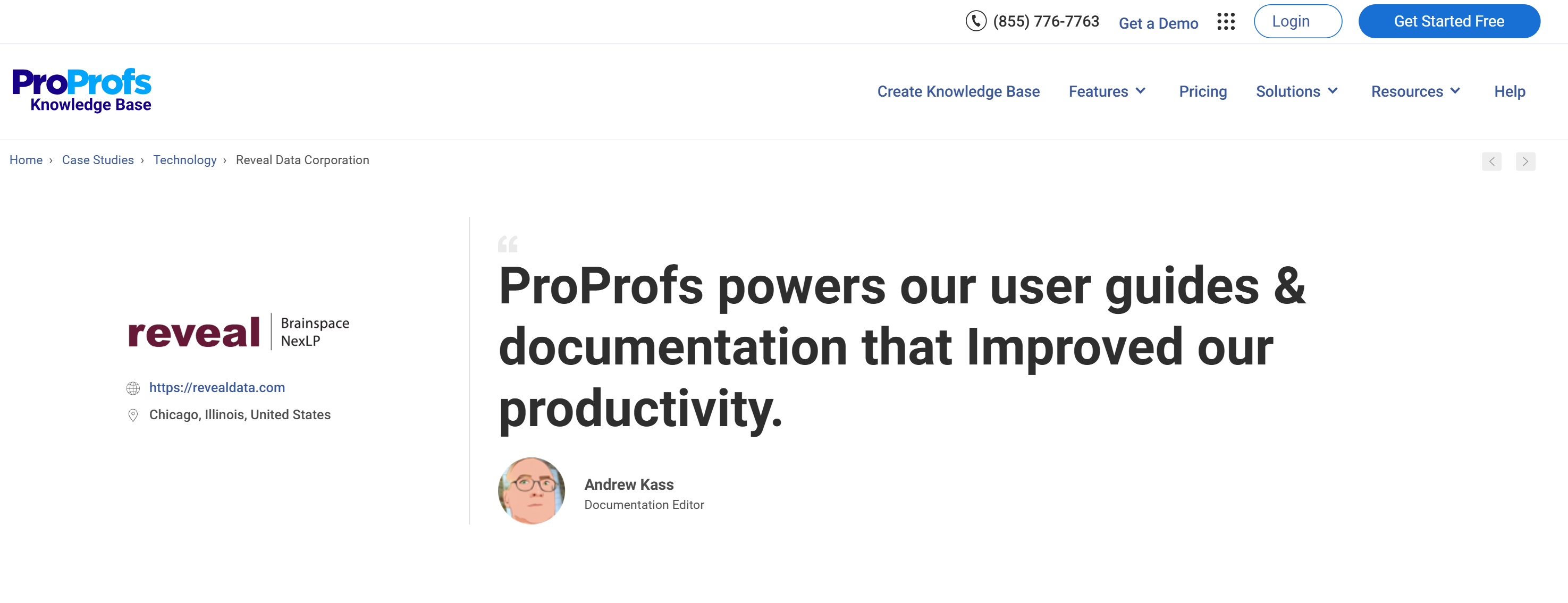
2. ClickHelp – Best for Team Collaboration
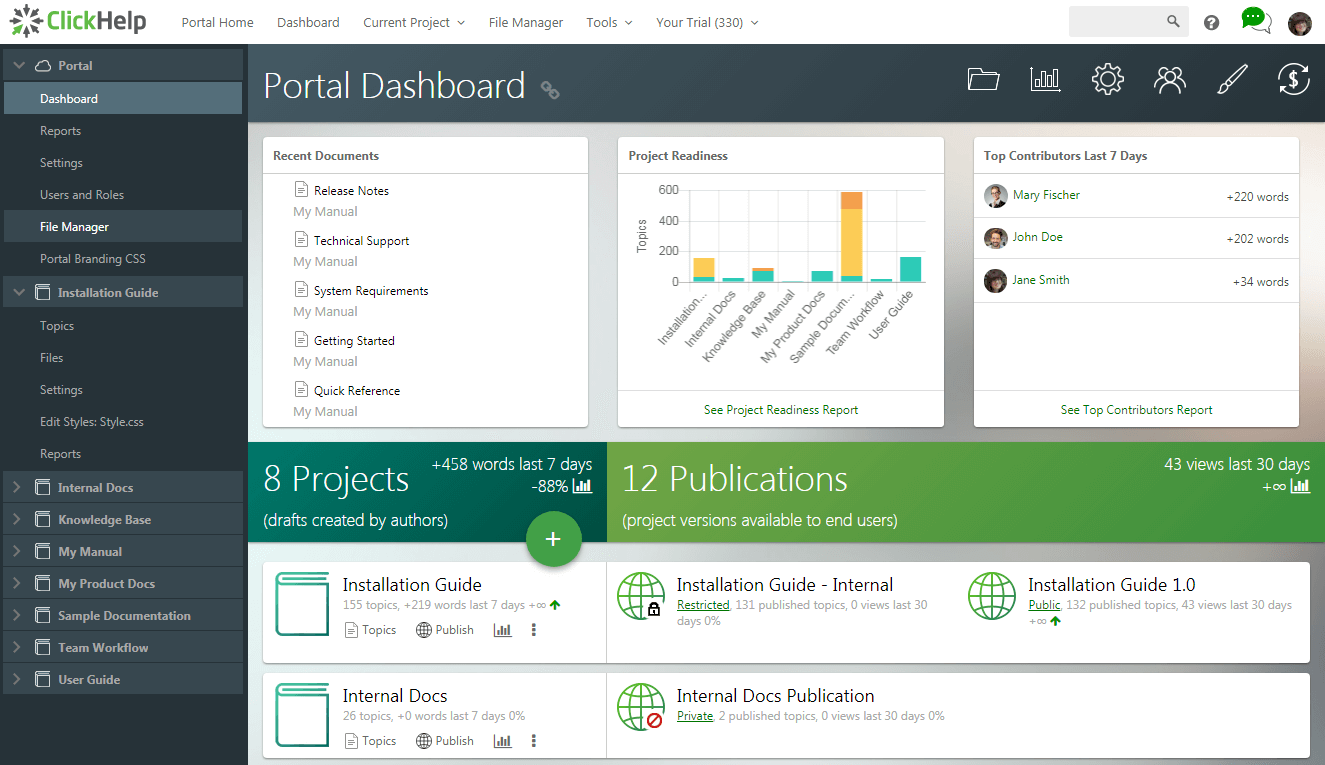
Image source: Scribe
With ClickHelp, you can effortlessly build user guides for internal and external use while maintaining multiple versions of articles. It also allows for seamless migration of existing information from tools like MS Word, Open Office, and HTML.
Additionally, it provides a flexible roles and permissions management system, ensuring that your manuals are protected from unauthorized access.
I like how it lets users view multiple documents and their versions in a single portal. This allows for easy access and management of different document versions, which makes it convenient to track changes and compare various iterations.
What You Will Like:
- Comprehensive reports and analytics
- Granular permission management
- Easy-to-use WYSIWYG editor for creating content.
Pricing:
Paid plan starts at $175/2 contributors/month.
Ideal For:
Software companies looking to publish developer documentation in multiple formats.
G2 Rating: 4.8/5
3. Scribe – Best for Generating Visual How-To Guides

Image source: Medium (Dheeraj Soni)
I love how Scribe automatically turns any process you perform on-screen into a step-by-step guide with screenshots and instructions. Whether you’re onboarding new employees or creating customer-facing how-to guides, Scribe helps you capture workflows effortlessly in real time.
One of its standout features is the browser extension and desktop app, which record your actions and instantly convert them into neatly formatted guides.
To make the content more useful and reader-friendly, you can edit steps, blur sensitive information, and add annotations or tips.
What You May Like:
- The ability to organize guides into shared spaces and folders
- Guides can be shared via links, embedded in wikis or knowledge bases, or exported as PDFs
- Smart editing tools: blur, highlight, and annotate instructions.
Pricing:
Paid plan starts at $23/seat/month.
Ideal For:
Startups and small teams looking to automate step-by-step user guide creation from screen recordings.
G2 Rating: 4.8/5
4. HelpDocs – Best for Fast Collaboration to Bring Knowledge, Docs & Projects Together in One Place
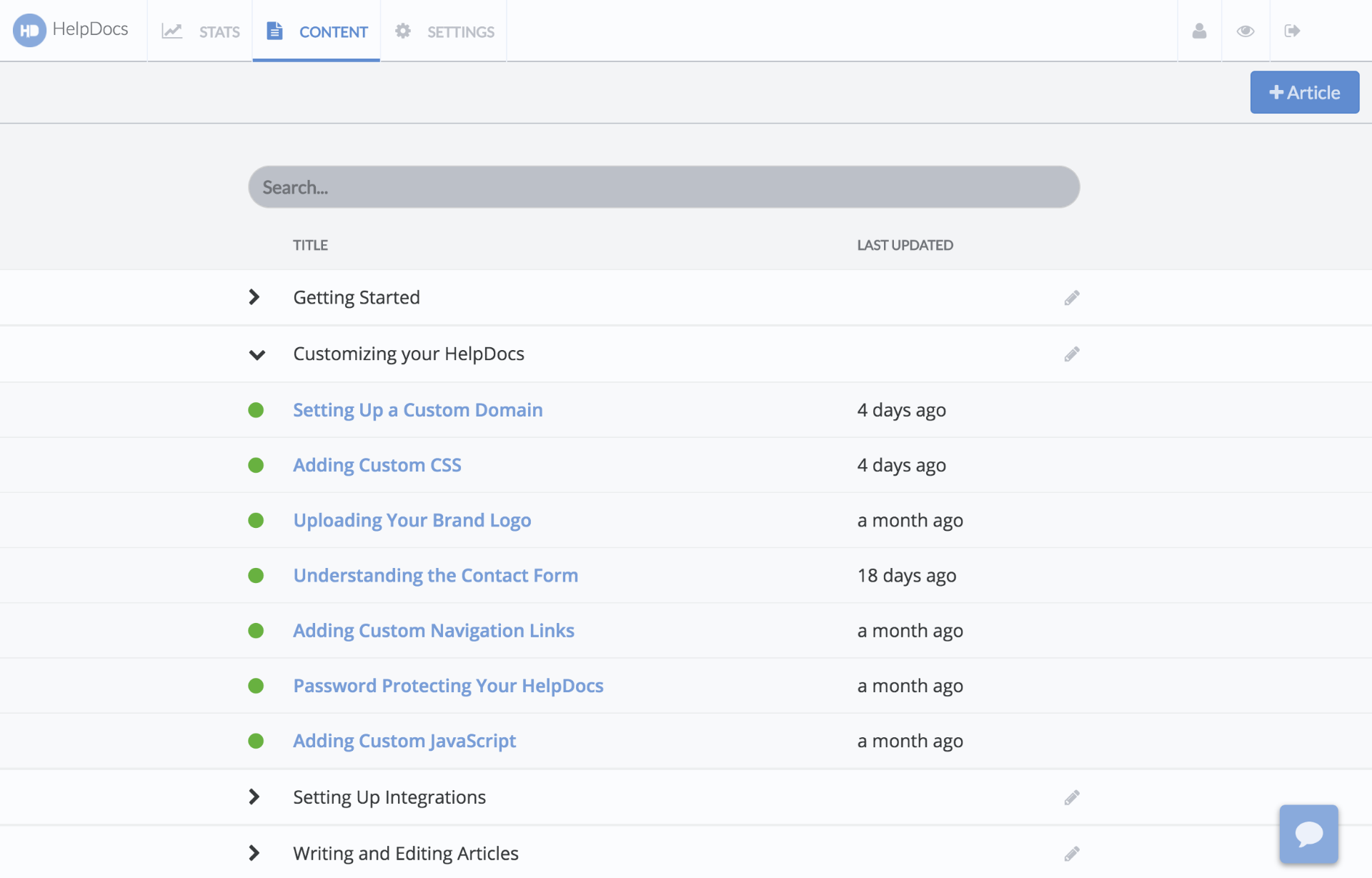
Image source: HelpDocs Bookmarked
HelpDocs enabled my team to design and tailor our manuals to match our brand identity, ensuring a seamless user experience. It allowed us to maintain a cohesive and professional appearance across all customer touchpoints.
It offers a range of intuitive tools for building and organizing knowledge bases, categorizing articles, dragging and dropping content, and easily updating and maintaining documentation.
Its analytics and monitoring tools helped us monitor trends, analyze traffic, and evaluate the effectiveness of our content.
What You Will Like:
- Extensive customization using CSS and JavaScript
- Monitor articles by most viewed, most searched, etc.
- Easy to export the reports and customize the dashboard via custom styles.
Pricing:
Paid plan starts at $55/month/team.
Ideal For:
SaaS startups looking to publish SEO-friendly self-service resources.
G2 Rating: 4.8/5
5. WhatFix – Best for Creating Interactive Help Content

Image source: Whatfix
Instead of traditional manuals, Whatfix lets teams build real-time walkthroughs, tooltips, and guided task lists that integrate directly into the software or application users are navigating. This in-context assistance reduces friction and eliminates the need for users to toggle between product and documentation, creating a smoother learning curve.
I particularly like its no-code editor, which allows teams to build interactive guides without developer support.
Content can be customized based on user roles, behavior, and application context, so every user sees only the most relevant information. This personalization makes onboarding, support, and training far more efficient and user-friendly.
What You May Like:
- Personalization based on user roles and behavior
- No-code content creation and editing
- SCORM-compliant content export for LMS compatibility.
Pricing:
Offers customized pricing.
Ideal For:
Enterprises looking to deliver in-app user manuals and real-time onboarding experiences.
G2 Rating: 4.6/5
6. Notion – Best for Creating Internal Wikis for Teams Sharing Informal Knowledge

Image source: Bad Frost
I like Notion’s flexible structure, collaborative features, and multimedia support. These allow teams to create, organize, and share user-friendly documentation.
Notion also allows teams to create structured and interconnected pages, ideal for organizing complex information within a user manual.
You can create pages for different sections, link related content, and embed various media types, such as images, videos, and interactive elements. This enables you to build a dynamic, engaging user manual that caters to different learning styles.
What You Will Like:
- User-friendly interface and easy to learn
- Allows multiple users to edit and contribute to the same document simultaneously
- Version history allows you to track changes and revert to previous versions if necessary.
Pricing:
Paid plan starts at $10/seat/month.
Ideal For:
Startups and small teams looking for a flexible, all-in-one workspace for internal documentation
G2 Rating: 4.7/5
7. Document360 – Best for Creating Online Documentation
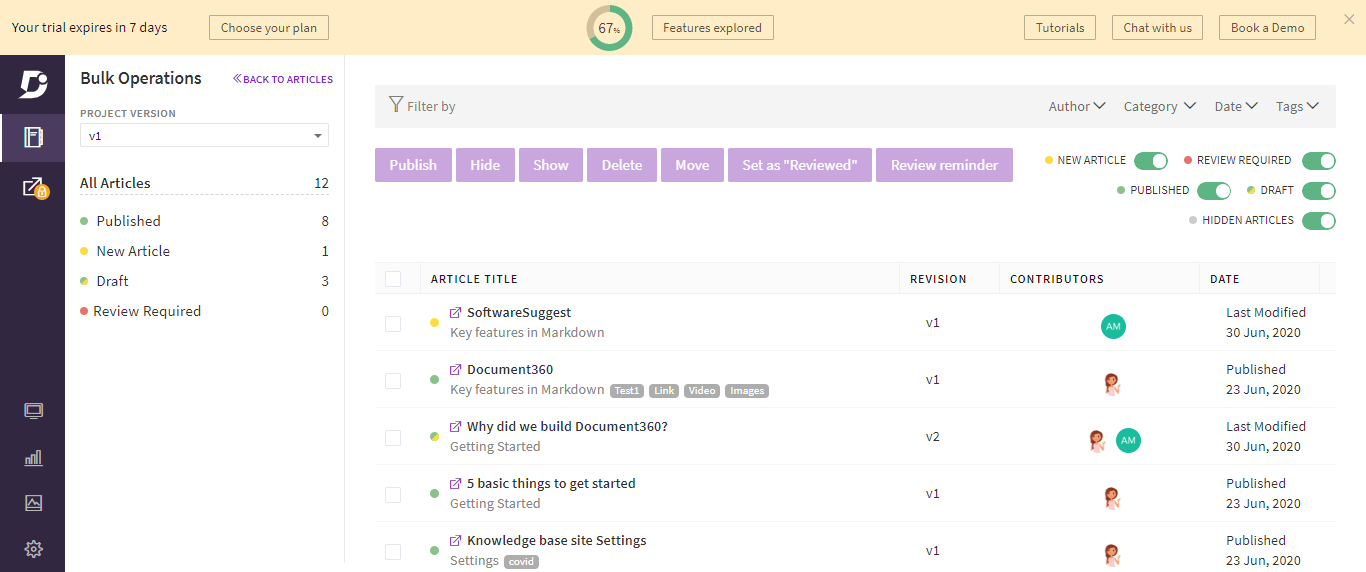
Image source: Document360
Document360‘s intuitive and user-friendly interface helps create user manuals. It organizes content in a structured manner, making it easy for users to navigate and find the information they need.
It also provides advanced search capabilities, enabling quick access to specific topics or keywords within the user manual.
I like its ability to facilitate collaboration among multiple editors, writers, and reviewers on creating and reviewing user manuals, ensuring the content is accurate and current.
What You Will Like:
- Advanced search capabilities for easy navigation
- Collaboration tools for efficient content creation and review process
- Analytics and reporting features for tracking user engagement
Pricing:
Document360 offers custom pricing.
Ideal For:
Mid-sized to large businesses that need a platform to manage customer-facing help sites.
G2 Rating: 4.7/5
8. Paligo – Best for Content Customization & Personalization

Image source: Paligo
I explored Paligo a few months ago and was impressed by its content customization and personalization. This feature allows users to tailor their content to specific audiences and publish it in various formats.
Its powerful multi-channel publishing capabilities enable users to write their content once and repurpose it to different output formats and channels with a simple click.
Paligo also offers structured authoring tools that promote accuracy, consistency, and future-proofing of content. It allows users to organize and categorize structured content using taxonomies, ensuring all information is accessible and reusable.
What You Will Like:
- Single source authoring
- Seamless localization and translation
- Versioning documentation is intuitive for anyone who has worked with any standard source control tool
Pricing:
Offers custom pricing.
Ideal For:
Enterprises in regulated industries looking for structured, multi-language documentation.
G2 Rating: 4.6/5
9. Dozuki – Best for Digitizing Manufacturing Knowledge
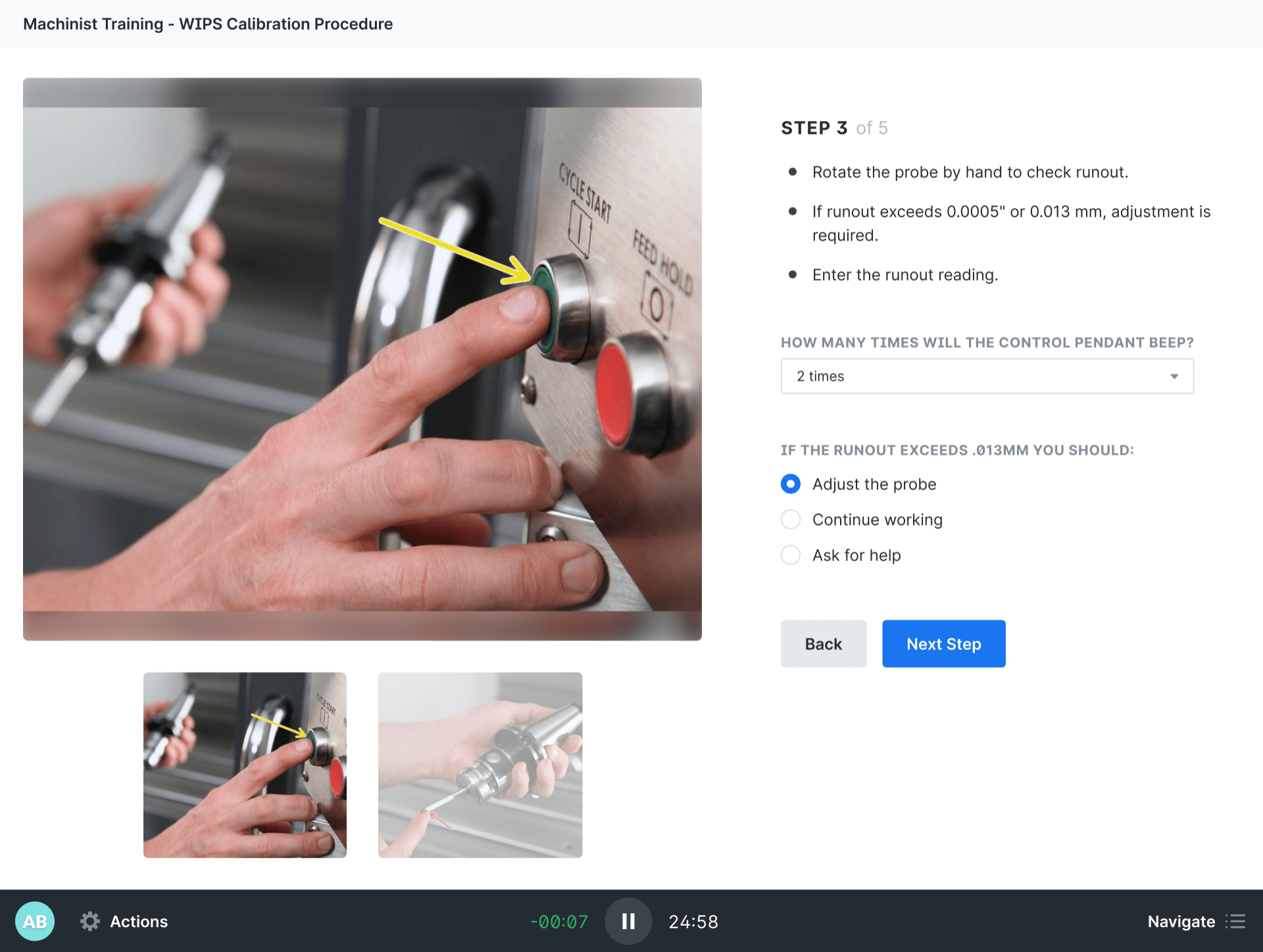
Image source: G2
I had to pick Dozuki as it is an excellent tool for digitizing manufacturing knowledge and providing seamless training to frontline workers. It helped me easily capture expert knowledge through photos and videos while tracking, approving, and releasing documented procedures.
It also offers many features to optimize and improve the manufacturing process. Workers can connect to external systems with LMS, QMS, and ERP integrations to review cycle time goals with live production data.
It provides an efficient way to gather and implement feedback from experienced employees, helping the company make better decisions.
What You Will Like:
- Easy to create visual instructions
- Adding pictures and videos is very intuitive
- The capability to enhance the picture quality in guides, making them more visually appealing and informative.
Pricing:
Offers custom pricing.
Ideal For:
Manufacturing and operations teams that need to create process-driven user manuals, SOPs, and work instructions.
G2 Rating: 4.4/5
10. GitBook – Best for Creating Smart Technical Documentation

Image source: Thomas Suedbroecker’s Blog
GitBook’s real-time collaborative editor allows multiple contributors to work on content simultaneously—perfect for product teams, engineers, and technical writers keeping fast-paced projects aligned.
The platform supports Markdown and rich text, so you can combine structured formatting with visual storytelling to make your manuals comprehensive and user-friendly.
The platform also includes built-in version control, enabling teams to track edits, manage revisions, and restore previous versions when needed. Whether you’re documenting software workflows, onboarding guides, or API references, GitBook makes collaboration seamless and publishing effortless.
What You Will Like:
- Custom themes and branding options to align your manuals with your company’s identity
- Third-party integrations (e.g., GitHub, Slack) to embed your manuals into your existing workflow
- Public and private access settings to manage visibility across teams or customers.
Pricing:
Paid plan starts at $8/user/month.
Ideal For:
Developer-centric teams and open-source projects that require clean, markdown-based user documentation with Git integration.
G2 Rating: 4.7/5
How to Choose the Right Tool for Your Needs & What to Consider
Choosing the right user manual creator ensures you can efficiently produce clear, professional documentation that boosts user satisfaction and reduces support queries.
- Look for an intuitive, easy-to-use interface
- Ensure the tool offers customization for design and content
- Check if it supports team collaboration with version control
- Ensure compatibility with your existing tools
- Choose one with multilingual support for a global audience
- Opt for tools with analytics to track user engagement.
Check out its insightful video to learn more about the same:
FREE. All Features. FOREVER!
Try our Forever FREE account with all premium features!
Deliver Clear Instructions with the Best User Manual Software
Choosing the right user manual creator software hinges on understanding your specific business needs, the complexity of your products, and your users’ preferences.
By carefully considering factors like ease of use, feature sets, collaboration options, and pricing, you can choose a tool that streamlines your documentation process and enhances the user experience.
ProProfs Knowledge Base is a strong contender, offering a user-friendly interface, user manual templates, and transparent pricing with a Forever Free Plan. Its integrated AI Writer can further accelerate content generation and improvement, making the process smoother and ensuring your user manuals are clear, comprehensive, and readily accessible.
Frequently Asked Questions
What is manual creation?
User manual creation involves designing and developing a document or guide that effectively provides users with instructions, information, and support on using a product, service, or system.
What is the best program to use to create a manual free?
Microsoft Word is a widely used program that offers a range of editing and formatting tools with various templates, making it a good choice for creating a manual for free
What is the best program to create a user manual?
ProProfs Knowledge Base is a recommended program for creating user manuals due to its intelligent features, AI text editor, rich template library, and multi-branding options, making creating engaging and interactive manuals easy.
How do you create a manual?
To create a manual, you typically start by outlining the content and structure, gathering information, and conducting research.
Next, you organize the data into sections, write clear and concise instructions, and add visuals like screenshots or diagrams.
Finally, proofread, edit, and format the manual to ensure readability and user-friendliness.
 Tips
Tips
We’d love to hear your tips & suggestions on this article!
FREE. All Features. FOREVER!
Try our Forever FREE account with all premium features!








